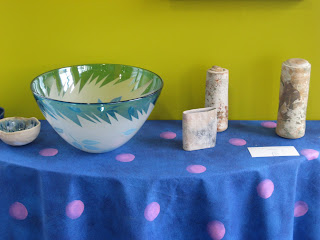 Paying Attention To "Fronts" And Entry Points in Your Antique Booth Or Shops
Paying Attention To "Fronts" And Entry Points in Your Antique Booth Or ShopsI have been studying how antique dealers concentrate on the "fronts" or entry points in their booths or shops.
The first places a visitor sees when visiting your booth are very important in an Antique Mall.
Creating Eye-Catching Displays
Obviously in a multi-group shop you want your goods to stick out and show off well. After all in a larger store, there are so many dealers that
 if you don't create an eye catching "front' how will you "pull-in" the buyers.
if you don't create an eye catching "front' how will you "pull-in" the buyers.And another reason to pay attention to the front of your booths is to get as much bang for your buck as possible. In other words, when you are leasing booth space, you want every inch to count.
Here are some tips to consider when organizing your displays in an Antique Mall.
1. Create colorful displays for the "front" of your booth.
2. Stay away from brown or dark shelves. Re-paint shelves in lighter colors.
3. Use white or glass shelves for the front of your booth or outside edge.
4. Consider using open shelves that you can peek inside the bo
 oth.
oth.5. Don't close your booth in.
6. Use attention getting objects on the entry to your booth., i.e. a quirky object, a humorous display, a good example of what you specialize in.
7. Add signs over your booth or on visible walls to attract folks to come to your booth.
8. Your glass cabinets should have mirrors and lighting.
9. Consider dressing up shelves with shelf edging or paint the edges another color.
10. Keep your displays interesting and not so crowded that you cant make out what is on display.
11. Hang objects on the sides and backs of shelves.
12. Dress forms with clothing and accessories are great attention getters.
C. Dianne Zweig is the author of Hot Kitchen & Home Collectibles of the 30s, 40s, 50s and Hot Cottage Collectibles for Vintage Style Homes. She is also the Editor of Iantiqueonline.com an actively growing internet based resource community for people who buy, sell or collect antiques, collectibles and art. You can find Dianne’s fabulous retro and vintage kitchen, home and cottage collectibles at The Collinsville Antiques Company of New Hartford, CT, a 22,000 feet antique emporium with an in-house retro café.To read more articles by C. Dianne Zweig click on this link: C. Dianne Zweig’s Blog Kitsch ‘n Stuff Email me at dianne@cdiannezweig.comVisit my website, CDianneZweig.comDianne is a member of:The American Society of Journalists and AuthorsThe Authors Guild, Inc.










.JPG)














